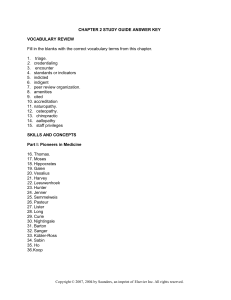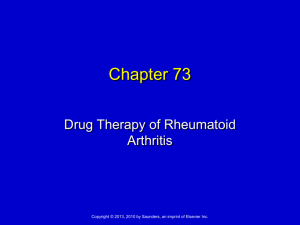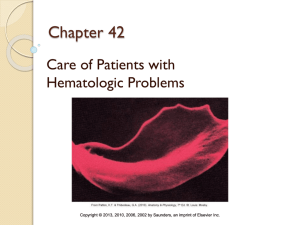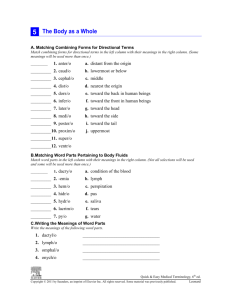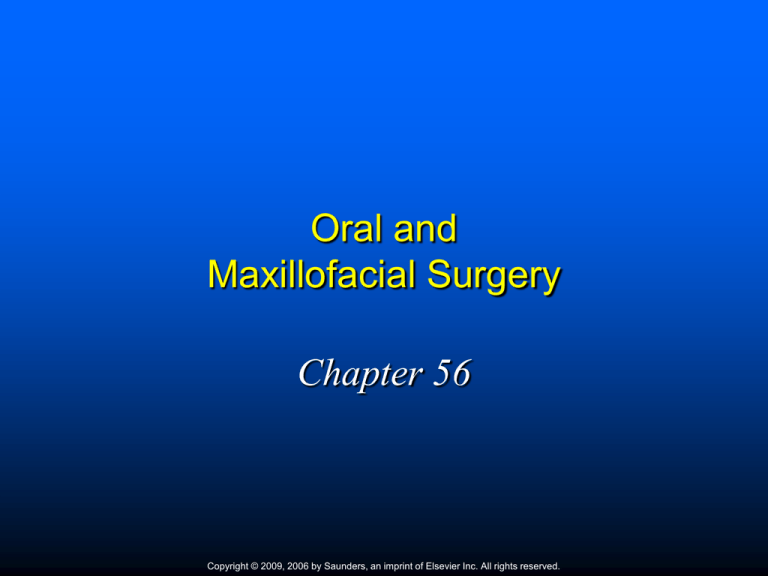
Oral and
Maxillofacial Surgery
Chapter 56
Copyright © 2009, 2006 by Saunders, an imprint of Elsevier Inc. All rights reserved.
Chapter 56
Lesson 56.1
Copyright © 2009, 2006 by Saunders, an imprint of Elsevier Inc. All rights reserved.
Learning Objectives
Pronounce, define, and spell the Key Terms.
Describe the specialty of oral and
maxillofacial surgery.
Discuss the role of an oral surgery assistant.
Identify specialized instruments used for
basic surgical procedures.
(Cont’d)
Copyright © 2009, 2006 by Saunders, an imprint of Elsevier Inc. All rights reserved.
Learning Objectives
(Cont’d)
Discuss the importance of the chain of
asepsis during a surgical procedure.
Prepare a sterile field.
Perform a surgical scrub.
Perform sterile gloving.
Copyright © 2009, 2006 by Saunders, an imprint of Elsevier Inc. All rights reserved.
Introduction
Oral and maxillofacial surgery is the
specialty of dentistry involving the
diagnosis and surgical treatment of
diseases, injuries, and defects.
Copyright © 2009, 2006 by Saunders, an imprint of Elsevier Inc. All rights reserved.
Indications for Maxillofacial Surgery
Extractions of decayed teeth that cannot be
restored
Surgical removal of impacted teeth
Extraction of nonvital teeth
Preprosthetic surgery to smooth and contour
the alveolar ridge
Removal of teeth for orthodontic treatment
Removal of root fragments
Removal of cysts and tumors
Biopsy
(Cont’d)
Copyright © 2009, 2006 by Saunders, an imprint of Elsevier Inc. All rights reserved.
Indications for Maxillofacial Surgery
(Cont’d)
Treatment of fractures of the mandible or
maxilla
Surgery to alter the size or shape of the facial
bones
Surgery of the temporomandibular joint
Reconstructive surgery
Cleft-lip and cleft-palate repairs
Salivary gland surgery
Surgical implant procedures
Copyright © 2009, 2006 by Saunders, an imprint of Elsevier Inc. All rights reserved.
The Surgical Assistant
Must have advanced knowledge and skills in:
Patient assessment and monitoring
Specialized instruments
Surgical asepsis
Surgical procedures
Pain-control techniques
Copyright © 2009, 2006 by Saunders, an imprint of Elsevier Inc. All rights reserved.
The Surgical Setting
Dental operatory
Surgical suite
Operating room
Copyright © 2009, 2006 by Saunders, an imprint of Elsevier Inc. All rights reserved.
Dental Instruments
It is critical for the surgical assistant
to have a working knowledge and
understanding of surgical
instruments.
Copyright © 2009, 2006 by Saunders, an imprint of Elsevier Inc. All rights reserved.
Elevators
Used to apply leverage against the tooth to
loosen it from the periodontal ligament and
ease extraction.
Types
Periosteal elevator
Straight elevator
Root-tip pick
Copyright © 2009, 2006 by Saunders, an imprint of Elsevier Inc. All rights reserved.
Fig. 56-2 Periosteal elevator.
(Courtesy of Miltex, Inc, York, Pa.)
Copyright © 2009, 2006 by Saunders, an imprint of Elsevier Inc. All rights reserved.
Fig. 56-3 Straight elevator.
(Courtesy of Miltex, Inc, York, Pa.)
Copyright © 2009, 2006 by Saunders, an imprint of Elsevier Inc. All rights reserved.
Fig. 56-4 Root-tip picks.
(Courtesy of Miltex, Inc, York, Pa.)
Copyright © 2009, 2006 by Saunders, an imprint of Elsevier Inc. All rights reserved.
Fig. 56-5 Commonly Used Forceps.
(Courtesy of Miltex, Inc, York, Pa.)
Copyright © 2009, 2006 by Saunders, an imprint of Elsevier Inc. All rights reserved.
Surgical Instruments
Surgical curette
Rongeur
Used to clean and scrape the interior of the tooth
socket to remove diseased tissue
Used to trim alveolar bone
Bone file
Used to smooth rough margins of the alveolus
(Cont’d)
Copyright © 2009, 2006 by Saunders, an imprint of Elsevier Inc. All rights reserved.
Fig. 56-6 Surgical curettes.
(Courtesy of Miltex, Inc, York, Pa.)
Copyright © 2009, 2006 by Saunders, an imprint of Elsevier Inc. All rights reserved.
Fig. 56-8 Bone file.
(Courtesy of Miltex, Inc, York, Pa.)
Copyright © 2009, 2006 by Saunders, an imprint of Elsevier Inc. All rights reserved.
Surgical Instruments
(Cont’d)
Scalpel
Hemostat
Surgical knife used to make precise incisions into
soft tissue
Used to grasp and hold things
Needle holder
Used to firmly grasp a suture needle
(Cont’d)
Copyright © 2009, 2006 by Saunders, an imprint of Elsevier Inc. All rights reserved.
Fig. 56-9 Scalpel handle and blade.
(Courtesy of Miltex, Inc, York, Pa.)
Copyright © 2009, 2006 by Saunders, an imprint of Elsevier Inc. All rights reserved.
Fig. 56-10 Hemostat.
(Courtesy of Miltex, Inc, York, Pa.)
Copyright © 2009, 2006 by Saunders, an imprint of Elsevier Inc. All rights reserved.
Fig. 56-11 Needle holders.
(Courtesy of Miltex, Inc, York, Pa.)
Copyright © 2009, 2006 by Saunders, an imprint of Elsevier Inc. All rights reserved.
Surgical Instruments
(Cont’d)
Surgical scissors
Suture scissors
Used to trimm soft tissue
Used to cutt suture material
Retractors
Used to hold or retract tissue during surgery
(Cont’d)
Copyright © 2009, 2006 by Saunders, an imprint of Elsevier Inc. All rights reserved.
Surgical Instruments
(Cont’d)
Mouth prop
Also known as a bite-block; allows the patient to
rest and relax the jaw muscles during surgery
Chisel
Either in a single-bevel or bi-bevel design; singlebevel type used for removing bone, bi-bevel for
splitting teeth
(Cont’d)
Copyright © 2009, 2006 by Saunders, an imprint of Elsevier Inc. All rights reserved.
Surgical Instruments
(Cont’d)
Mallet
Source of pressure used on the chisel handle
Surgical burs
Used to remove bone or to cut or split the crowns
or roots of teeth
Copyright © 2009, 2006 by Saunders, an imprint of Elsevier Inc. All rights reserved.
Surgical Asepsis
Because surgical procedures invade
open tissue, the surgical team must
follow sterile technique.
(Cont’d)
Copyright © 2009, 2006 by Saunders, an imprint of Elsevier Inc. All rights reserved.
Surgical Asepsis
(Cont’d)
Sterile field
Surgical scrub
Site where surgical instruments and accessory
items are placed during the surgery
Type of hand wash used to lessen the chance of
infection
Sterile gloving
Required for assistance in an invasive procedure
Copyright © 2009, 2006 by Saunders, an imprint of Elsevier Inc. All rights reserved.
Preparing for Surgery
Advance preparation
Have all patient records and radiographs in order.
Have consent forms signed and available.
Information requested from the patient’s physician
must have been received.
Check for laboratory cases.
Ensure that surgical setups have been prepared
and sterilized.
Provide preoperative instructions for any
premedication.
(Cont’d)
Copyright © 2009, 2006 by Saunders, an imprint of Elsevier Inc. All rights reserved.
Preparing for Surgery
(Cont’d)
Treatment-room preparation
Place protective barriers.
Keep surgical instruments in their sterile wraps
until they are to be used.
Have the appropriate pain-control medications set
out and ready for administration.
Have the postoperative instructions ready to
provide to the patient.
(Cont’d)
Copyright © 2009, 2006 by Saunders, an imprint of Elsevier Inc. All rights reserved.
Preparing for Surgery
(Cont’d)
Patient preparation
Update the medical history and laboratory reports.
Confirm with the patient that any prescribed
premedication was taken as directed.
Place the radiographs on a view box.
Take vital signs for a baseline.
Seat and drape the patient.
Position the chair.
(Cont’d)
Copyright © 2009, 2006 by Saunders, an imprint of Elsevier Inc. All rights reserved.
Preparing for Surgery
(Cont’d)
During surgery
Maintain the chain of asepsis.
Transfer and receive instruments.
Provide aspiration and retraction as needed.
Maintain a clear operating field with light.
Monitor the patient’s vital signs.
Steady the patient’s head and mandible
if necessary.
Observe the patient’s condition and anticipate the
surgeon’s needs.
(Cont’d)
Copyright © 2009, 2006 by Saunders, an imprint of Elsevier Inc. All rights reserved.
Preparing for Surgery
(Cont’d)
After surgery
Stay with the patient.
Give verbal and written postoperative instructions.
Schedule a postoperative visit.
Update the patient’s treatment records.
Return the patient’s records to the
business assistant.
Break down and disinfect the treatment area.
Copyright © 2009, 2006 by Saunders, an imprint of Elsevier Inc. All rights reserved.
Chapter 56
Lesson 56.2
Copyright © 2009, 2006 by Saunders, an imprint of Elsevier Inc. All rights reserved.
Learning Objectives
Describe surgical procedures typically
performed in a general practice.
Assist in a simple extraction.
Assist in a multiple-extraction procedure with
alveoplasty.
Assist in the removal of an impacted tooth.
Copyright © 2009, 2006 by Saunders, an imprint of Elsevier Inc. All rights reserved.
Forceps Extraction
Forceps extraction is the surgical removal
of a tooth that is fully erupted and has a
solid, intact crown that can be grasped
firmly with the forceps.
Copyright © 2009, 2006 by Saunders, an imprint of Elsevier Inc. All rights reserved.
Multiple Extractions and Alveoloplasty
Multiple extraction procedure involving the
contouring and smoothing of the alveolar
crest of the surgical site.
Copyright © 2009, 2006 by Saunders, an imprint of Elsevier Inc. All rights reserved.
Removal of Impacted Teeth
A complex extraction of a tooth that has not
erupted
Soft-tissue impaction
Hard-tissue impaction
Copyright © 2009, 2006 by Saunders, an imprint of Elsevier Inc. All rights reserved.
Biopsy
The surgical removal and examination of
lesions in the oral cavity
Incisional biopsy
Excisional biopsy
Exfoliative cytology
Copyright © 2009, 2006 by Saunders, an imprint of Elsevier Inc. All rights reserved.
Chapter 56
Lesson 56.3
Copyright © 2009, 2006 by Saunders, an imprint of Elsevier Inc. All rights reserved.
Learning Objectives
Assist in suture placement.
Perform suture removal.
Describe the postoperative care given to a
patient after a surgical procedure.
Discuss the possible complications of
surgery.
Assist in the treatment of alveolitis (dry
socket).
Copyright © 2009, 2006 by Saunders, an imprint of Elsevier Inc. All rights reserved.
Sutures
Sutures are the stitches placed to control bleeding
and promote healing.
Copyright © 2009, 2006 by Saunders, an imprint of Elsevier Inc. All rights reserved.
Types of Sutures
Absorbable
Plain catgut provides the fastest healing for
mucous membranes and subcutaneous tissues.
Chromic catgut provides a much slower healing,
allowing the internal tissues to heal first.
Vicryl is a synthetic absorbable material.
Nonabsorbable
Silk is used for its strength and ease of use.
Polyester fiber is one of the strongest sutures.
Nylon is used for its strength and elasticity.
Copyright © 2009, 2006 by Saunders, an imprint of Elsevier Inc. All rights reserved.
Suture Removal
When nonabsorbable sutures are
placed, the patient is scheduled to
return to have them removed in
approximately 5 to 7 days.
Copyright © 2009, 2006 by Saunders, an imprint of Elsevier Inc. All rights reserved.
Postoperative Care
Control of bleeding
A 2 × 2-inch piece of gauze is folded and placed to
control bleeding and encourage clot formation and
healing.
• Keep gauze in place for 30 minutes.
• If bleeding does not stop, call the dental office.
• Do not disturb the clot with your tongue or by rinsing your
mouth vigorously.
• Strenuous work or physical activity is restricted that day.
(Cont’d)
Copyright © 2009, 2006 by Saunders, an imprint of Elsevier Inc. All rights reserved.
Postoperative Care
(Cont’d)
Control of swelling
Ibuprofen is used before and after surgery.
During the first 24 hours, a cold pack is placed in a
cycle of 20 minutes on/20 minutes off.
After the first 24 hours, external heat is applied to
the area of the face in question to increase
circulation in the tissues and to promote healing.
After the first 24 hours, the patient may begin
gently rinsing the oral cavity with warm saline
solution.
Copyright © 2009, 2006 by Saunders, an imprint of Elsevier Inc. All rights reserved.
Postsurgical Complications
Alveolitis (dry socket)
Causative factors
Inadequate blood supply to the socket
Trauma to the socket
Infection within the socket
Dislodgment of the clot from the socket
Copyright © 2009, 2006 by Saunders, an imprint of Elsevier Inc. All rights reserved.





